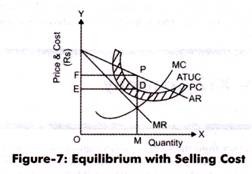Selling costs can be defined as costs necessary for persuading customers to purchase a product from a seller instead of another seller.
In perfect competition, organizations do not incur selling costs as buyers are fully aware about product features and prices.
The products of organizations are close substitutes of each other, but not perfect substitutes. Organizations under monopolistic competition are generally indulged in non-price competition.
Non-price competition refers to competition among sellers for promoting the sales of products through various modes other than price cutting. These modes can be advertisements, after sales services, and other promotional activities.
ADVERTISEMENTS:
Monopolistically competitive organizations always strive to differentiate their products from the products of competitors, so that profits can be maximized. In addition, in monopolistic competition, organizations are required to persuade consumers to purchase their products. In such a condition, advertisements play a crucial role in attracting consumers.
However, advertising and other promotional activities of organizations always involve certain costs, which are known as selling costs. In other words, selling costs can be defined as costs necessary for persuading customers to purchase a product from a seller instead of another seller. In perfect competition, organizations do not incur selling costs as buyers are fully aware about product features and prices.
Advertisements can be of two types, promotional or competitive. A promotional advertisement aims at providing general information related to the industry and promoting its sales. On the other hand, a competitive advertisement is used to push the demand of products of an organization against another.
The effect of advertisement would be different if the purpose of advertisement is different. An advertisement can be profitable for one organization, while it may incur heavy losses for another organization. In addition, it is not always necessary that a promotional activity would result in increasing brand loyalty among customers.
ADVERTISEMENTS:
Sometimes, advertisement may lead to promotional wars among competitors. One organization competes with the other in terms of their promotional expenditure and activities. Therefore, the impact of selling cost may be immense including positive as well as negative.
Effect of Selling Costs on Demand Curve:
Selling costs are necessary for increasing the demand for a product by attracting new customers and retaining the existing customers. Therefore, the demand of an organization before sales promotion is different from the demand curve drawn after sales promotion. However, the elasticity of these two demand curves may not be equal. It depends on the buying habits of new consumers.
If the buying habits of consumers change with change in the price of a product, then the new demand curve would be more elastic than the old one and vice versa. For example, if consumers find a product to be purchased only at lower rates, then the demand curve would be more elastic. On the other hand, if they are ready to purchase a good quality product at any price, then the demand curve is less elastic.
ADVERTISEMENTS:
Advertisement and sales promotions enable sellers to shift the demand curve. Influential advertisements help in attracting customers, which automatically increases the profits of an organization. Consequently, there would be a shift in the demand curve. Now, the demand curve would become less elastic.
This helps the seller to raise the prices of his/her products. However, if the seller is not able to reduce elasticity of demand, he/she would decrease the prices, so that there would be increase in sales. Therefore, sellers mostly focus on increasing sales and profit through advertisements.
Selling Costs and Equilibrium Output:
The sale of a product can be increased by adopting three methods, namely advertising, lowering down the prices, and improving the quality of the product. Among all these three methods, advertisements play a crucial role in enhancing the sales of an organization.
Advertisements and other promotional activities of an organization incur selling costs. The addition of selling costs in the total cost makes it difficult to find out the most profitable output. Increase in selling cost may result in increase in total output sold at the same price or the same output sold at the increased price.
The equilibrium output including selling cost can be determined with the help of the following formula:
Net Returns = (Price * Output) – (Production cost + selling cost)
The equilibrium output can be obtained by determining the output level that provides maximum net returns. Selling cost would be taken as fixed cost in the demand curve build after including the selling cost to determine the maximum net returns.
Figure-7 shows the fixed selling cost and demand curve:
In Figure-7, MR represents the marginal revenue curve, AR denotes average revenue curve, ATUC is average total unit cost, and PC is the average production cost. The shaded area between ATUC and PC represents the selling cost. When selling cost and average production cost are taken together, it is termed as average total unit cost.
The difference between the price (MP) and average cost (MD) signifies the net revenue per unit (DP) with output level OM/ED. In the present case, the difference between the total revenue (OMPF) and total cost (OMDE) represents the maximum net return (DPFE).
In Figure-7, the maximum net returns are determined by assuming that the selling costs are fixed. In case, the selling costs are variable, then the net returns would be calculated in a different manner.
In such a case, the following formula would be used by taking different probable outputs into account:
ADVERTISEMENTS:
Net returns = (Price * Output) – (Production cost + selling cost)
Using the aforementioned formula, an organization calculates the net return for all the possible outputs and selects the most profitable output.
